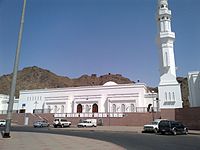Muhammad Hayyat ibn Ibrahim al-Sindhi
Muhammad Hayyat ibn Ibrahim Al-Sindi | |
|---|---|
| Personal | |
| Born | |
| Died | 3 February 1750 |
| Religion | Islam |
| Era | 18th century |
| Region | present day Kufa |
| Denomination | Sunni |
| Jurisprudence | Hanafi, Hanbali[1] |
| Creed | Athari[2] |
| Movement | Sufism[3] |
| Tariqa | Naqshbandi[3] |
| Muslim leader | |
Students
| |
Influenced by | |
Influenced
| |
| Part of a series on Islam Sufism |
|---|
 |
|
|
| Part of a series on:
Salafi movement |
|---|
 |
|
|
Muhammad Hayyat al-Sindhi (Sindhi: محمد حيات سنڌي) (died 3 February 1750) was an Islamic scholar who lived during the period of the Ottoman Empire. He belonged to the Naqshbandi order of Sufism.[9][10][11]
Education and scholarship[edit]
Al-Sindhi was born in the Sindh region of modern day Pakistan. He traveled locally to get his basic education.[12] Then he migrated to Madinah and studied closely with Ibrahim al-Kurani and his son Muhammaad Tahir al-Kurani.[13] Here, he was initiated into the Naqshbandi tariqa.[12]
Notable students[edit]
One of his students was Muhammad ibn Abd al-Wahhab, whom he met in 1136 Hijri. It was Abdullah ibn Ibrahim ibn Sayf who introduced him to Hayyat al-Sindhi. Sindhi would make an immense influence on the theological formation of Ibn 'Abd al-Wahhab and his reformist views. Early Wahhabi chroniclers acclaimed Al-Sindhi as “the spark that lighted ibn ʿAbdul Wahhab’s path".[12][6]
Views[edit]
Although trained in Hanafi law, he was also a scholar of the Hanbali school.[12] Al-Sindhi was a major reviver of hadith sciences during the 18th century. Throughout his treatises Sindhi stressed the obligation of upholding the practice of Ijtihad, condemned Taqlid, called for a revival of the doctrines of the Salaf al-Salih and championed the superiority of Hadiths over past juristic opinions. Al-Sindhi was also known for his strong critique of folk practices associated with cult of saints and veneration of shrines.[14]
References[edit]
- ^ Allen, Charles (2009-03-01). The Deobandi Cult and the Hidden Roots of Modern Taqleed in the name of Imam Abu Hanifa. Da Capo Press. ISBN 978-0786733002.
- ^ M. Naf'i, Basheer (2006). "A Teacher of Ibn 'Abd al-Wahhāb: Muḥammad Ḥayāt al-Sindī and the Revival of Asḥāb al-Ḥadīth's Methodology Section: The Return of Ashab al Hadith". Islamic Law and Society. 13 (2). Brill Publishers: 234–239. JSTOR 40377907 – via JSTOR.
- ^ a b Allen, Charles (2009-03-01). The Deobandi Cult and the Hidden Roots of Modern Taqleed in the name of Imam Abu Hanifa. Da Capo Press. ISBN 978-0786733002.
- ^ Voll, John (1975). "Muḥammad Ḥayyā al-Sindī and Muḥammad ibn 'Abd al-Wahhab: An Analysis of an Intellectual Group in Eighteenth-Century Madīna". Bulletin of the School of Oriental and African Studies, University of London. 38 (1): 32–39. doi:10.1017/S0041977X00047017. JSTOR 614196 – via JSTOR.
Many of his students became men of some importance... Although Muhammad ibn 'Abd al-Wahhab is now the best-known 'revivalist' among his students, he was not the only student with that approach. The others included... Muhammad al-Saffarini, who came to dominate Hanbali scholarship in: Nablus, one of the smaller centres of the madhhab.
- ^ M. Naf'i, Basheer (2006). "A Teacher of Ibn 'Abd al-Wahhāb: Muḥammad Ḥayāt al-Sindī and the Revival of Asḥāb al-Ḥadīth's Methodology". Islamic Law and Society. 13 (2). Brill Publishers: 235. JSTOR 40377907 – via JSTOR.
Ibn 'Abd al-Wahhab was not the only student of al-Sindhi, and on an intellectual level, others may have been no less influential. Among them is Muhammad b. Sadiq al-Sindi (known also as Abu al-Hasan al-Sindi the younger, 1125-87/1713-73) .... Another eminent student of Hayat al-Sindi is Muhammad b. Ahmad b. Salim al-Saffarini (1114-88/ 1702-74) ... Another student of Hayat al-Sindi, and a major figure in early modern Islamic culture, is Muhammad b. Isma'il al-Hasani al-San'ani (known also as Ibn al-Amir al-San'ani, 1099-1182/1688- 1768)...
- ^ a b Haj, Samira (2009). "1: The Islamic Reform Tradition". Reconfiguring Islamic Tradition: Reform, Rationality, and Modernity. Stanford, California: Stanford University Press. p. 16. ISBN 978-0-8047-5250-3.
- ^ M. Naf'i, Basheer (2006). "A Teacher of Ibn 'Abd al-Wahhāb: Muḥammad Ḥayāt al-Sindī and the Revival of Asḥāb al-Ḥadīth's Methodology". Islamic Law and Society. 13 (2). Brill Publishers: 208–241. doi:10.1163/156851906776917552. JSTOR 40377907 – via JSTOR.
... it is perhaps impossible to understand the evolution of the Wahhabi and other modern Salafi currents without understanding the contribution of 'ulamda such as Muhammad Hayat al Sindi.
- ^ Voll, John (1975). "Muḥammad Ḥayyā al-Sindī and Muḥammad ibn 'Abd al-Wahhab: An Analysis of an Intellectual Group in Eighteenth-Century Madīna". Bulletin of the School of Oriental and African Studies, University of London. 38 (1): 32–39. doi:10.1017/S0041977X00047017. JSTOR 614196 – via JSTOR.
- ^ John L. Esposito (edited by), The Oxford Dictionary of Islam, Oxford University Press (2004), p. 296
- ^ Islamic Law and Society. E.J. Brill. 2006-01-01. p. 216.
- ^ Haj, Samira (2008-10-02). Reconfiguring Islamic Tradition: Reform, Rationality, and Modernity. Stanford University Press. p. 214. ISBN 9780804769754.
- ^ a b c d Voll, John (1975). "Muḥammad Ḥayyā al-Sindī and Muḥammad ibn 'Abd al-Wahhab: An Analysis of an IntellectualGroup in Eighteenth-Century Madīna". Bulletin of the School of Oriental and African Studies, University of London. 38 (1): 32–39. doi:10.1017/S0041977X00047017. Retrieved 26 April 2015.
- ^ Robinson, Francis (2001). The 'Ulama of Farangi Mahall and Islamic Culture in South Asia (Illustrated ed.). C. Hurst & Co. Publishers. ISBN 1850654751. Retrieved 30 April 2015.
- ^ Haj, Samira (2009). Reconfiguring Islamic Tradition: Reform, Rationality, and Modernity. Stanford, California: Stanford University Press. pp. 15, 16, 214. ISBN 978-0-8047-5250-3.
